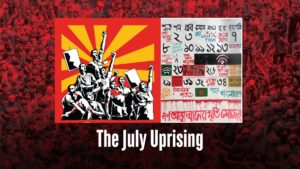July Uprising

A Litmus Test for Bangladesh Economy
It began with a verdict. Not a speech, not a scandal—just a quiet ruling from Bangladesh’s judiciary. On June 5, 2024, the High Court reinstated a quota system for government jobs, reserving 56 percent of positions for specific groups, including descendants of freedom fighters. For many students, it felt like a door slamming shut. Within days, campuses across the country stirred with frustration. The movement that followed—Students Against Discrimination—was born not in fury, but in resolve. Their rallies were orderly, their chants measured. But beneath the surface, tension simmered. By early July, that tension boiled over. The protests evolved into the “Bangla Blockade,” a sweeping shutdown of roads and highways that paralysed the nation’s arteries. Buses vanished. Containers stacked up at ports. Supply trucks idled outside factories. Dhaka’s markets emptied as perishables spoiled in the heat. Exporters missed deadlines. Small traders watched their earnings evaporate. What began as a student movement had metastasized into an economic crisis. DEFINING MOMENTS June 5 | 2024 High Court reinstates quotas June 7-15 | 2024 Students begin peaceful rally, social media activism July 01 | 2024 Nationwide Bangla Blockade begins July 16 | 2024 Violent crackdown, leaving dozens killed Late July | 2024 FDI approvals drop 40%; export delays, gas shortages August 5 | 2024 Interim Government formed Sep–Dec | 2024 Interest hits 10%; ADP spending 49-year low Jan–Mar | 2025 Remittances peak; inflation eases; current account surplus Apr–Jul | 2025 Recovery phase: DSEX up 12.5%; exports rebound; MFS grows 64% August 5 | 2025 One-Year Anniversary A Nation on Edge On July 16 of 2024, the calm shattered. Security forces moved in with batons, tear gas, and live ammunition. The clashes were brutal. Ambulances raced through smoke-filled streets. Students lay bloodied on stretchers. Families camped outside police stations, desperate for news. Independent monitors reported hundreds injured and dozens dead. The government disputed the numbers. But the images—broadcast across television screens and social media—left little room for doubt. The shockwaves were immediate. Investor confidence collapsed. The Dhaka Stock Exchange saw its sharpest single-day drop in five years. Foreign direct investment approvals fell nearly 40 percent in the second half of 2024, according to the Dhaka Chamber of Commerce and Industry. The city, once buzzing with commerce, fell into a hush. Three weeks later on August 5, an interim government was announced, led by Nobel laureate Muhammad Yunus along with a panel of technocrats and civil society leaders. Their mandate: restore stability, rebuild trust, and prevent further economic unraveling. The Economic Aftershocks The July Uprising, as it came to be known, left no sector untouched. While the garment and ceramic sectors bore the immediate brunt, the ripple effects extended far wider. The banking system, already strained by years of financial irregularities, teetered on collapse. A post-uprising asset quality review revealed widespread non-performing loans and misappropriated funds, prompting the interim government to initiate recovery drives and liquidity injections. The Bangladesh Bank raised the policy rate to 10 percent to tame inflation and stabilise the exchange rate. Net foreign direct investment (FDI) dropped to a five-year low in 2024, as global investors cited political instability and opaque regulatory frameworks. The World Bank flagged Bangladesh’s deteriorating investment climate, while local chambers warned that the budget lacked a clear roadmap for restoring investor confidence. The energy sector faced dual shocks: gas shortages crippled industrial output, while privatisation efforts triggered an 18 percent hike in urban electricity tariffs, sparking fresh protests. The mental health toll was staggering. A Bangladesh Medical University seminar revealed that 82.5% of injured protesters suffered from depression, and 64% showed signs of post-traumatic stress disorder, underscoring the long-term human cost of the crisis. In the ceramic industry, 70 factories struggled to stay afloat. The Bangladesh Ceramic Manufacturers and Exporters Association (BCMEA) reported that gas pressure—critical for kiln operations—dropped to as low as 2 PSI in some zones, far below the required 15. Production stalled. Costs soared. Their demands were precise: uninterrupted gas supply, priority allocation, compressor permissions, a five-year tariff freeze, and duty-free solar imports. None were met. The garment sector fared no better. The Bangladesh Garment Manufacturers and Exporters Association (BGMEA) confirmed shipment delays averaging two weeks during the unrest. Export Promotion Bureau (EPB) data showed a 7.8% decline in garment exports in Q3 of 2024. Buyers in Europe and North America have shifted orders to Vietnam and India. Smaller exporters faced penalties and lost contracts, according to the Bangladesh Knitwear Manufacturers and Exporters Association (BKMEA). The Foreign Investors’ Chamber of Commerce and Industry (FICCI) called for stronger rule of law, faster customs clearance, and smoother approvals. The Bangladesh Chamber of Industries (BCI) highlighted the plight of agro-processors, many of whom faced wastage and layoffs. Their appeal: concessional loans and tax relief. Even real estate, long seen as a safe haven, stumbled. The Real Estate and Housing Association of Bangladesh (REHAB) reported a sharp drop in property transactions, citing high registration fees, interest rates, and uncertainty over the Detailed Area Plan (DAP) revisions. Across industries, the message converged: without urgent reform, Bangladesh’s hard-earned gains risked slipping away. The Numbers Behind the Crisis The numbers told a sobering story. By late 2024, exports faltered, imports shrank, and growth slowed to its weakest pace in years. The disruptions that began with student protests soon seeped into every corner of the economy, from factories to food markets. Inflation surged through the summer, eroding wages and squeezing households already under strain. Though the pace of price rises eased the following year, the scars remained. Construction sites went quiet, housing demand collapsed, and long-promised infrastructure projects were postponed. The slowdown was no longer abstract—it showed in half-finished bridges and shuttered shops. Private investment also lost its footing. Business registrations dwindled, banks groaned under bad loans, and confidence withered. Even as revenue collection improved, it could not
Read More
